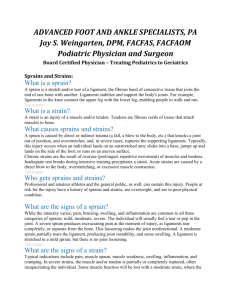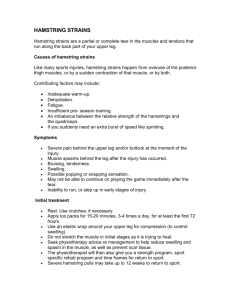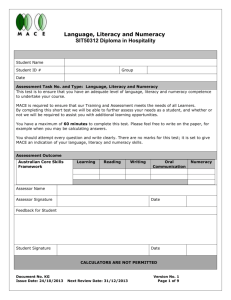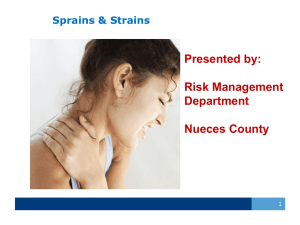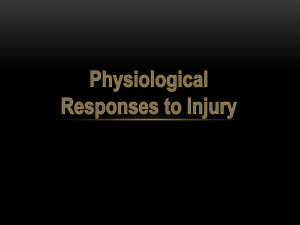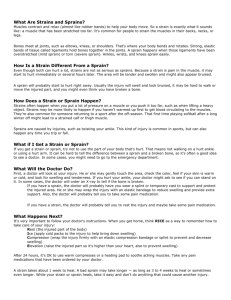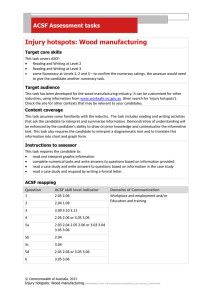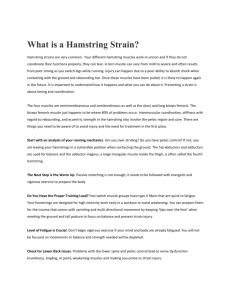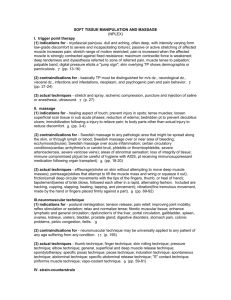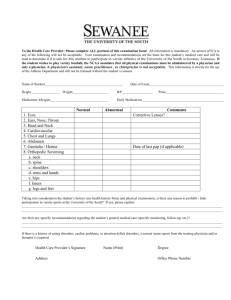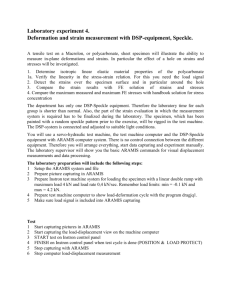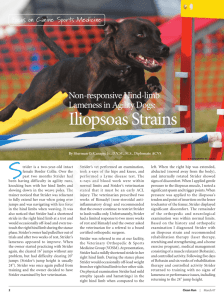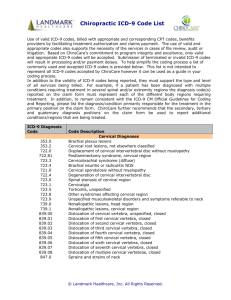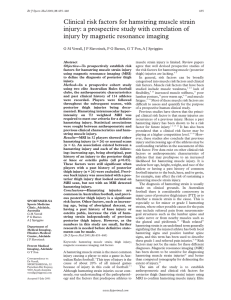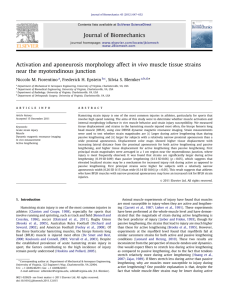Sprains
advertisement
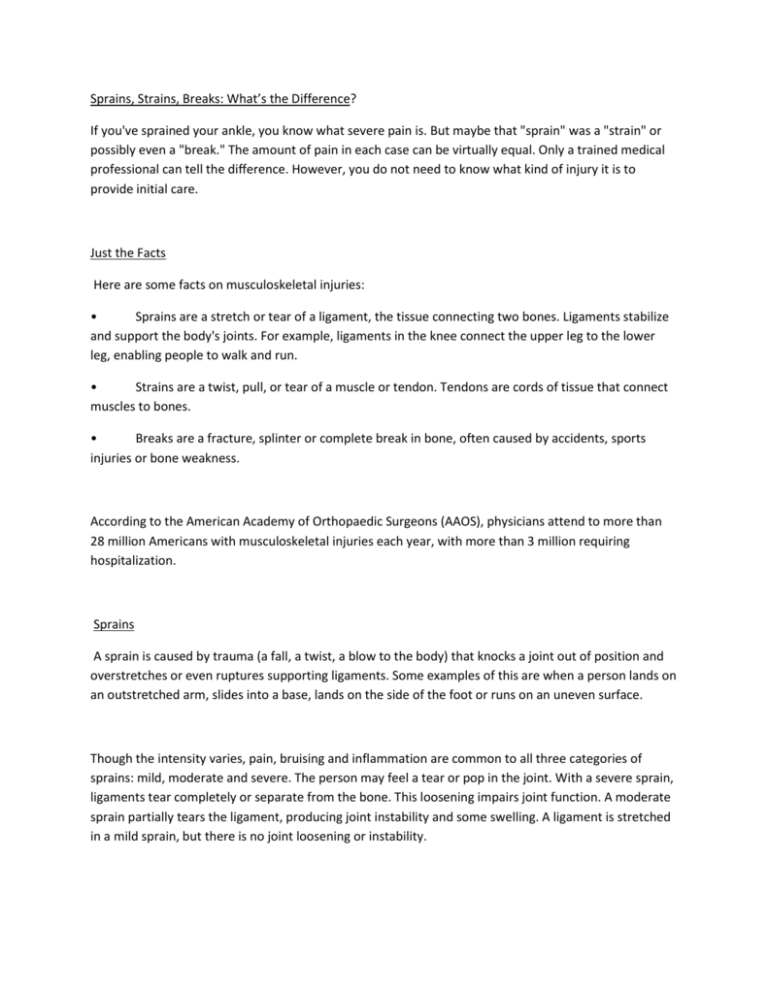
Sprains, Strains, Breaks: What’s the Difference? If you've sprained your ankle, you know what severe pain is. But maybe that "sprain" was a "strain" or possibly even a "break." The amount of pain in each case can be virtually equal. Only a trained medical professional can tell the difference. However, you do not need to know what kind of injury it is to provide initial care. Just the Facts Here are some facts on musculoskeletal injuries: • Sprains are a stretch or tear of a ligament, the tissue connecting two bones. Ligaments stabilize and support the body's joints. For example, ligaments in the knee connect the upper leg to the lower leg, enabling people to walk and run. • Strains are a twist, pull, or tear of a muscle or tendon. Tendons are cords of tissue that connect muscles to bones. • Breaks are a fracture, splinter or complete break in bone, often caused by accidents, sports injuries or bone weakness. According to the American Academy of Orthopaedic Surgeons (AAOS), physicians attend to more than 28 million Americans with musculoskeletal injuries each year, with more than 3 million requiring hospitalization. Sprains A sprain is caused by trauma (a fall, a twist, a blow to the body) that knocks a joint out of position and overstretches or even ruptures supporting ligaments. Some examples of this are when a person lands on an outstretched arm, slides into a base, lands on the side of the foot or runs on an uneven surface. Though the intensity varies, pain, bruising and inflammation are common to all three categories of sprains: mild, moderate and severe. The person may feel a tear or pop in the joint. With a severe sprain, ligaments tear completely or separate from the bone. This loosening impairs joint function. A moderate sprain partially tears the ligament, producing joint instability and some swelling. A ligament is stretched in a mild sprain, but there is no joint loosening or instability. Strains Acute strains are caused by a direct blow to the body, overstretching or excessive muscle contraction. Chronic strains are the result of overuse—prolonged, repetitive movement—of muscles and tendons. Inadequate rest during intense training can cause a strain. Typical indications of strain include pain, muscle spasm, muscle weakness, swelling, inflammation and cramping. In severe strains, the muscle and/or tendon is partially or completely ruptured, leaving a person incapacitated. Some muscle function will be lost with a moderate strain, where the muscle/tendon is overstretched and slightly torn. With a mild strain, the muscle/tendon is stretched or pulled, slightly. One common strain is back strain - when the muscles that support the spine are twisted, pulled or torn. Athletes who engage in excessive jumping (during basketball or volleyball, for example) are vulnerable to this injury. A hamstring muscle strain is a tear or stretch of a major muscle in the back of the thigh. The injury can sideline a person for up to six months. The likely cause is muscle strength imbalance between the hamstrings and the muscles in the front of the thigh, the quadriceps. Kicking a football, running or leaping to make a basket can pull a hamstring. Hamstring injuries tend to recur. Breaks Bone breaks and fractures should always be looked at by a physician to ensure proper healing and connection. If an injury has not been examined by a physician and/or its pain does not subside, seek a professional opinion. Treat injuries with RICE A severe sprain or strain may require surgery or immobilization followed by a period of physical therapy. Mild sprains and strains may require rehabilitation exercises and activity modification during recovery. In all but mild cases, a medical doctor should evaluate the injury and establish a treatment and rehabilitation plan. Meanwhile, RICE (rest, immobilize, cold and elevate) will usually help minimize damage caused by sprains and strains. This process should be started immediately after the injury and continued off-andon for about 72 hours. RICE relieves pain, minimizes swelling and speeds healing, and it is often the best treatment for soft-tissue injuries, such as sprains and strains. Rest: The injured area should be moved as little as possible to allow healing to begin. Immobilize: Using a pressure bandage helps to prevent or reduce swelling. Use an elastic, or ACE, bandage. Wrap the injured area without making it so tight that it will restrict the blood supply. Splint the injured part if the person must be moved and it does not cause more pain. Cold: Apply it immediately to reduce inflammation, which causes more pain and slows healing. Cover the injured area with an ice pack (inside a wet cloth) and apply the ice for 20 minutes intermittently for 48 to 72 hours. Never ice for more than 20 minutes because it can cause a nerve injury. Elevate: Raise the injured area above the level of the heart if it does not cause more pain. Prop up a leg or arm while resting it. You may need to lie down to get your leg above your heart level. Do all four parts of the RICE treatment at the same time. If you suspect a more serious injury, such as a broken bone, don't hesitate to consult with your health care provider immediately.
